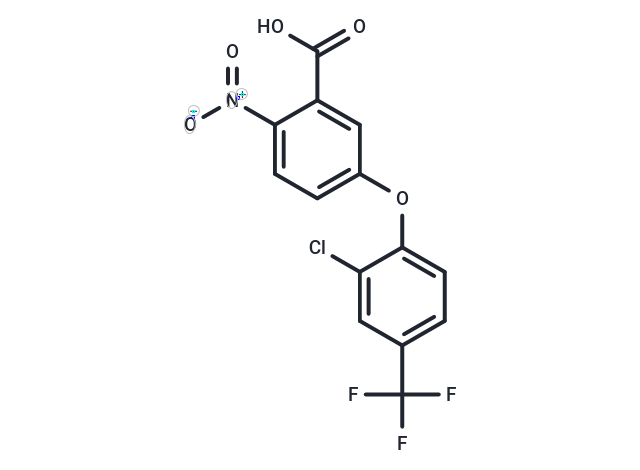Shopping Cart
Remove All Your shopping cart is currently empty
Your shopping cart is currently empty
Acifluorfen is a protoporphyrinogen oxidase (PPO) inhibitor herbicide that promotes the accumulation of protoporphyrin IX. It induces liver tumors, liver injury, and cardiac dysfunction in rodents, and causes severe photooxidative damage to pigments and lipids in susceptible plants. It can be used to induce hepatitis and pancreatitis.

| Pack Size | Price | USA Warehouse | Global Warehouse | Quantity |
|---|---|---|---|---|
| 50 mg | $41 | In Stock | In Stock | |
| 100 mg | $61 | In Stock | In Stock | |
| 200 mg | $89 | In Stock | In Stock | |
| 1 mL x 10 mM (in DMSO) | $44 | In Stock | In Stock |
| Description | Acifluorfen is a protoporphyrinogen oxidase (PPO) inhibitor herbicide that promotes the accumulation of protoporphyrin IX. It induces liver tumors, liver injury, and cardiac dysfunction in rodents, and causes severe photooxidative damage to pigments and lipids in susceptible plants. It can be used to induce hepatitis and pancreatitis. |
| In vitro | To examine the link between herbicide efficacy and intrinsic antioxidants, this study explores the impact of Acifluorfen on cucumber (Cucumis sativus L.) cotyledon disc levels of glutathione and ascorbate. Acifluorfen significantly reduces glutathione and ascorbate concentrations by more than 50% in discs exposed to white light (450 microeinsteins per square meter per second) for under 1.5 hours. Additionally, Acifluorfen precipitates rapid ascorbate depletion in plants grown under far-red light, which lack photosynthetic capability [2]. |
| In vivo | Dietary treatment with 2500 ppm Acifluorfen for up to 13 weeks increases Cyp2b10 expression in the livers of wild-type mice, but not in CAR-knockout (CARKO) mice. Microscopically, Acifluorfen treatment-induces cytotoxic changes, including hepatocellular necrosis and inflammation, and causes regenerative changes accompanied by prolonged increases in the numbers of proliferating cell nuclear antigen-positive hepatocytes in WT mice [1]. These results indicated that prolonged cytotoxicity in the liver was a key factor for ACI-induced hepatocarcinogenesis, and that CAR played an important role in ACI-induced liver injury and tumor development in mice. |
| Molecular Weight | 361.66 |
| Formula | C14H7ClF3NO5 |
| Cas No. | 50594-66-6 |
| Smiles | OC(=O)c1cc(Oc2ccc(cc2Cl)C(F)(F)F)ccc1[N+]([O-])=O |
| Relative Density. | 1.647 g/cm3 |
| Storage | Powder: -20°C for 3 years | In solvent: -80°C for 1 year | Shipping with blue ice/Shipping at ambient temperature. | |||||||||||||||||||||||||||||||||||
| Solubility Information | DMSO: 60 mg/mL (165.9 mM), Sonication is recommended. | |||||||||||||||||||||||||||||||||||
| In Vivo Formulation | 10% DMSO+90% Corn Oil: 2.5 mg/mL (6.91 mM), Sonication is recommeded. Please add the solvents sequentially, clarifying the solution as much as possible before adding the next one. Dissolve by heating and/or sonication if necessary. Working solution is recommended to be prepared and used immediately. The formulation provided above is for reference purposes only. In vivo formulations may vary and should be modified based on specific experimental conditions. | |||||||||||||||||||||||||||||||||||
Solution Preparation Table | ||||||||||||||||||||||||||||||||||||
DMSO
| ||||||||||||||||||||||||||||||||||||
| Size | Quantity | Unit Price | Amount | Operation |
|---|

Copyright © 2015-2025 TargetMol Chemicals Inc. All Rights Reserved.